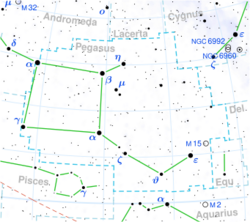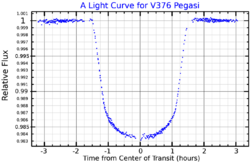Astronomy:HD 209458
| Observation data Equinox J2000.0]] (ICRS) | |
|---|---|
| Constellation | Pegasus |
| Right ascension | 22h 03m 10.77275s[1] |
| Declination | +18° 53′ 03.5494″[1] |
| Apparent magnitude (V) | 7.65[2] |
| Characteristics | |
| Evolutionary stage | main sequence |
| Spectral type | F9 V[3] or G0 V[4] |
| Apparent magnitude (B) | 8.244[2] |
| Apparent magnitude (K) | 6.308±0.026[2] |
| B−V color index | +0.574±0.014[5] |
| Variable type | EP[6] |
| Astrometry | |
| Radial velocity (Rv) | −14.78±0.16[1] km/s |
| Proper motion (μ) | RA: 29.766(28)[1] mas/yr Dec.: −17.976(25)[1] mas/yr |
| Parallax (π) | 20.7694 ± 0.0266[1] mas |
| Distance | 157.0 ± 0.2 ly (48.15 ± 0.06 pc) |
| Absolute magnitude (MV) | 4.28±0.10[5] |
| Details | |
| Mass | 1.148±0.022[7] M☉ |
| Radius | 1.203±0.061[7] R☉ |
| Luminosity | 1.77±0.14[7] L☉ |
| Temperature | 6071±20[7] K |
| Metallicity [Fe/H] | 0.00±0.02[5] dex |
| Rotation | 14.4 days[citation needed] |
| Rotational velocity (v sin i) | 4.228±0.007[8] km/s |
| Age | 3.5±1.4[7] Gyr |
| Other designations | |
| Database references | |
| SIMBAD | data |
| Exoplanet Archive | data |
| Extrasolar Planets Encyclopaedia | data |
HD 209458 is a star with an orbiting exoplanet in the constellation Pegasus. It has an apparent visual magnitude of 7.65[2] and an absolute magnitude of 4.28.[5] Because it is located at a distance of 157 light-years (48 parsecs) from the Sun as measured via parallax, it is not visible to the unaided eye. With good binoculars or a small telescope it should be easily detectable. The system is drifting closer with a heliocentric radial velocity of −14.8 km/s.[1]
The spectrum of HD 209458 presents as a late F- or early G-type main-sequence star with a stellar classification of F9 V[3] or G0 V,[4] respectively. It is roughly 3.5[7] billion years old and is spinning with a projected rotational velocity of 4.2 km/s.[8] The star displays a moderate amount of magnetic activity in its chromosphere.[10] It has a 15% greater mass than the Sun and a 20% larger radius. The abundance of iron, a measure of the metallicity of the star, is solar.[7] HD 209458 is radiating 1.8 times the luminosity of the Sun from its photosphere at an effective temperature of 6,071 K.[7]
Because the planet transits the star, the star is dimmed by about 2% every 3.5 days making it an extrinsic variable. The variable star designation for HD 209458 is V376 Pegasi. It is the prototype of the variable class "EP" in the General Catalogue of Variable Stars, defined as stars showing eclipses by their planets.[6][11]
Planetary system
In 1999, two teams working independently (one team consisted of astronomers at the Geneva Observatory, the Center for Astrophysics | Harvard & Smithsonian, and the Wise Observatory; the second group was the California and Carnegie Planet Search team) discovered an extrasolar planet orbiting the star by using the radial velocity planet search method. Soon after the discovery, separate teams led by David Charbonneau and Gregory W. Henry were able to detect a transit of the planet across the surface of the star making it the first known transiting extrasolar planet.[4][13] The planet received the designation HD 209458 b.
The planet is now under even more public scrutiny with the announcement that its atmosphere contains water vapor. Astronomers had made careful photometric measurements of several stars known to be orbited by planets, in the hope that they might observe a dip in brightness caused by the transit of the planet across the star's face. This would require the planet's orbit to be inclined such that it would pass between the Earth and the star, and previously no transits had been detected.
Travis Barman at Lowell Observatory in Flagstaff, Arizona analyzed the emission spectrum of this planet in 2007, and believes that its atmosphere contains water vapor,[14] although previous research in 2007[15] suggests that the atmosphere is composed mostly of silicate clouds. A spectrum taken in 2020 detected either sodium or titanium oxide in the planet's atmosphere.[16] A later study in 2021 did not find any molecular absorption features in the planetary atmosphere at all.[17]
| Companion (in order from star) |
Mass | Semimajor axis (AU) |
Orbital period (days) |
Eccentricity | Inclination | Radius |
|---|---|---|---|---|---|---|
| b | 0.682+0.014 −0.015 MJ |
0.04707+0.00045 −0.00047 |
3.52474859(38) | <0.0081 | 86.71±0.05° | 1.359+0.016 −0.019 RJ |
See also
References
- ↑ 1.0 1.1 1.2 1.3 1.4 1.5 Vallenari, A. et al. (2022). "Gaia Data Release 3. Summary of the content and survey properties". Astronomy & Astrophysics. doi:10.1051/0004-6361/202243940 Gaia DR3 record for this source at VizieR.
- ↑ 2.0 2.1 2.2 2.3 Anderson, E.; Francis, Ch. (2012). "XHIP: An extended hipparcos compilation". Astronomy Letters 38 (5): 331. doi:10.1134/S1063773712050015. Bibcode: 2012AstL...38..331A.
- ↑ 3.0 3.1 Gray, R. O. et al. (2001). "The Physical Basis of Luminosity Classification in the Late A-, F-, and Early G-Type Stars. I. Precise Spectral Types for 372 Stars". The Astronomical Journal 121 (4): 2148. doi:10.1086/319956. Bibcode: 2001AJ....121.2148G.
- ↑ 4.0 4.1 4.2 Charbonneau, David et al. (2000). "Detection of Planetary Transits Across a Sun-like Star". The Astrophysical Journal Letters 529 (1): L45–L48. doi:10.1086/312457. PMID 10615033. Bibcode: 2000ApJ...529L..45C.
- ↑ 5.0 5.1 5.2 5.3 Mazeh, Tsevi et al. (2000). "The Spectroscopic Orbit of the Planetary Companion Transiting HD 209458". The Astrophysical Journal 532 (1): L55–L58. doi:10.1086/312558. PMID 10702131. Bibcode: 2000ApJ...532L..55M.
- ↑ 6.0 6.1 "GCVS query result: V376 Peg". General Catalog of Variable Stars. Sternberg Astronomical Institute, Moscow, Russia. http://www.sai.msu.su/groups/cluster/gcvs/cgi-bin/search.cgi?search=V376+Peg.
- ↑ 7.0 7.1 7.2 7.3 7.4 7.5 7.6 7.7 Del Burgo, C.; Allende Prieto, C. (2016). "Accurate parameters for HD 209458 and its planet from HST spectrophotometry". Monthly Notices of the Royal Astronomical Society 463 (2): 1400–1408. doi:10.1093/mnras/stw2005. Bibcode: 2016MNRAS.463.1400D.
- ↑ 8.0 8.1 8.2 Bonomo, A. S. et al. (June 2017). "The GAPS Programme with HARPS-N at TNG. XIV. Investigating giant planet migration history via improved eccentricity and mass determination for 231 transiting planets". Astronomy & Astrophysics 602: A107. doi:10.1051/0004-6361/201629882. Bibcode: 2017A&A...602A.107B.
- ↑ "HD 209458". SIMBAD. Centre de données astronomiques de Strasbourg. http://simbad.u-strasbg.fr/simbad/sim-basic?Ident=HD+209458.
- ↑ Ben-Jaffel, Lotfi (December 2007). "Exoplanet HD 209458b: Inflated Hydrogen Atmosphere but No Sign of Evaporation". The Astrophysical Journal 671 (1): L61–L64. doi:10.1086/524706. Bibcode: 2007ApJ...671L..61B.
- ↑ Samus, N. N. (2009). "GCVS Variability Types and Distribution Statistics of Designated Variable Stars According to their Types of Variability". http://www.sai.msu.su/groups/cluster/gcvs/gcvs/iii/vartype.txt.
- ↑ Brown, Timothy M. et al. (May 2001). "Hubble Space Telescope Time-Series Photometry of the Transiting Planet of HD 209458". The Astrophysical Journal 552 (2): 699–709. doi:10.1086/320580. Bibcode: 2001ApJ...552..699B.
- ↑ "Astronomers witness silhouette of planet crossing distant star" (Press release). Kamuela, Hawaii: W. M. Keck Observatory. November 7, 1999. Retrieved August 13, 2019.
- ↑ Barman, T. (2007). "Identification of Absorption Features in an Extrasolar Planet Atmosphere". The Astrophysical Journal Letters 661 (2): L191–L194. doi:10.1086/518736. Bibcode: 2007ApJ...661L.191B.
- ↑ Richardson, L. J. et al. (2007). "A spectrum of an extrasolar planet". Nature 445 (7130): 892–895. doi:10.1038/nature05636. PMID 17314975. Bibcode: 2007Natur.445..892R.
- ↑ Santos, N. C. et al. (2020). "Broadband transmission spectroscopy of HD 209458b with ESPRESSO: Evidence for Na, TiO, or both". Astronomy & Astrophysics 644: A51. doi:10.1051/0004-6361/202039454. Bibcode: 2020A&A...644A..51S.
- ↑ Casasayas-Barris, N. et al. (2021). "The atmosphere of HD 209458b seen with ESPRESSO". Astronomy & Astrophysics 647: A26. doi:10.1051/0004-6361/202039539. Bibcode: 2021A&A...647A..26C.
External links
Coordinates: ![]() 22h 03m 10.8s, 18° 53′ 04″
22h 03m 10.8s, 18° 53′ 04″
 |




